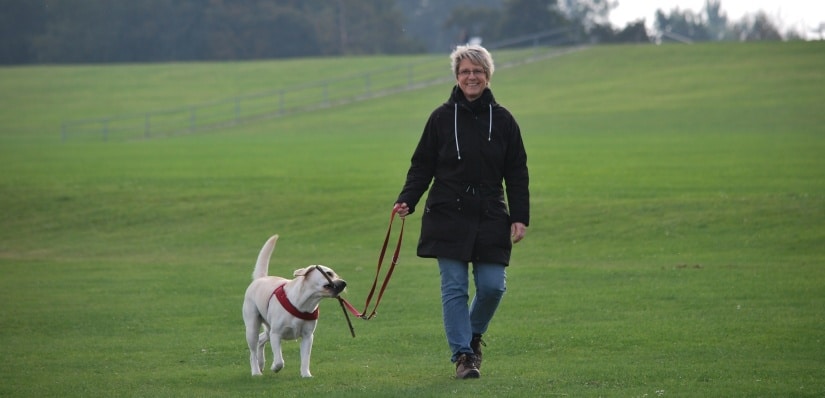For pet owners, one of the most challenging parts of caring for their furry friends is dealing with age-related health conditions such as arthritis. Almost all dogs will eventually develop joint and mobility issues due to osteoarthritis, a progressive degenerative disease that affects the joints in dogs. Although there’s no way to completely prevent arthritis from developing in later years, there are many steps you can take now to help your canine companion cope better with existing symptoms. In this article, we’ll discuss ten tips for making life more comfortable and pain-free for your dog suffering from arthritis.
What Is Arthritis In Dogs?
Arthritis in dogs is a degenerative joint disorder that can cause pain and decreased range of motion due to inflammation and degenerative joint changes. Generally occurring with age, arthritis can manifest in many ways, from limping and difficulty climbing stairs to decreased activity levels or changes in behavior. While it may not be possible to reverse the effects of arthritis, early diagnosis and treatment can help reduce discomfort, slow disease progression, and allow dogs to maintain an acceptable quality of life.
Causes:
Arthritis in dogs can occur due to many causes, both environmental and genetic factors. Environmental causes could include trauma from a physical injury such as sprains or strains, extreme climbing or jumping, obesity, and extended exercise on hard surfaces. Similarly, genetic conditions such as hip dysplasia that develop over time can also contribute to joint pain and arthritis. Additionally, large breeds of dogs are more prone to developing arthritis because their joints absorb more weight than smaller breeds. Regular visits to the Vet for checkups can help ensure your pup stays healthy and happy! Pet owners must be aware of their dog’s activity level to prevent any long-term damage from occurring.
Symptoms:
Signs of Pain
The most obvious symptom of arthritis is pain. If your dog yelps or cries out when they move, that is a sign of pain due to arthritis. Other signs include avoiding activity and limping or favoring one leg over another when walking or running. You may sometimes notice your dog panting more than usual because their increased movement causes discomfort.

Weight Loss
Arthritis can cause weight loss in dogs if they can no longer exercise as much as they used to due to joint pain. Additionally, weight loss can be caused by decreased appetite due to chronic pain associated with arthritis. It is crucial to monitor your dog’s weight for any changes and make sure it stays within the normal range for its size and age.
Decreased Mobility
Another symptom of arthritis in dogs is decreased mobility; if your pup used to love taking long walks but now struggles to walk even short distances, it could be a sign of arthritis. You may also notice stiffness or difficulty getting up or down from comfortable places like couches or beds, indicating something wrong with their joints or bones. Additionally, some dogs may develop a “bunny hopping” gait where they seem unable to pick up their feet correctly while walking; this is often an indication of hip dysplasia which can worsen over time if left untreated.
Licking At Joints
Dogs may lick at their affected joints as a way of providing relief from the pain associated with arthritis. If you notice your pup licking at certain areas more than usual, it could indicate something is wrong and should be looked into by a veterinarian as soon as possible.
Here Are 10 Tips You Can Use To Help Your Dog With Arthritis
1. Exercise Regularly
Exercise is essential to any pet’s life, but it can be even more beneficial for dogs with arthritis. Daily exercise helps keep their joints flexible and moving, increases their circulation, and strengthens the musculoskeletal system. The consistent activity also improves overall balance, reducing stress on their joints while exercising. Regular exercise allows your dog to enjoy increased mobility and agility, allowing them to run and play like they used to! It’s essential to check with your Vet before implementing an exercise program for a dog with arthritis so that the correct type of activity and amount is recommended. An exercise plan tailored to your pup’s needs will help them reap all the great benefits routine activity offers.

2. CBD For Dogs
Pet owners take comfort in knowing there are natural alternatives to harsh treatments for painful ailments like arthritis. Cannabidiol, or CBD, is one of those options. It is non-toxic, non-psychoactive, and non-addictive – ideal for use on your beloved four-legged friends. CBD for Dogs can offer a gentler solution with fewer side effects when treating your pet’s joint discomfort without giving them chemical medications. Although more research needs to be done, current studies have explored the potential benefits of CBD for pain management in pets with arthritis and other musculoskeletal conditions.
Providing your dog with all the care and support she needs is essential to her well-being. If your pup is suffering from arthritis, you may consider various CBD products to help ease her discomfort and improve her quality of life. CBD-based products for dogs are available in various forms, such as oils, treats, soft chews, and capsules. Each product type has unique benefits and can be tailored to your dog’s needs. Choosing the right one for your four-legged pal can be a great way to provide gentle relief when managing chronic pain at home. CBD can be beneficial when giving for arthritis in dogs.

3. Keep Their Weight in Check
Protecting your dog’s joint health is crucial for their well-being, and keeping them at their ideal weight can play an important role. Many veterinarians believe that carrying even a few extra pounds increases their risk of developing arthritis. Therefore, ensuring your pet is eating the right amount of food to maintain a healthy weight could help reduce the chances of developing arthritis in later life. Feeding a proper diet and regular exercise will keep them active and vital and aid in joint health maintenance. These measures provide extra support for older dogs who may be more prone to this condition, so getting on top of it early will benefit you and your pup now and in the future.
4. Give Them Supplements
It can be hard to watch your beloved pet age and suffer from painful ailments like arthritis. However, providing them with the right supplements can reduce the discomfort associated with this ailment. Supplementing your dog’s diet can help to build up their joints, make it easier for them to move around, and reduce inflammation. The right dietary supplement will also provide your pet with essential vitamins and minerals that can help keep their immune system strong and fight off other disease-causing pathogens. Through proper supplementation and proper care, your dog may find relief from uncomfortable arthritis symptoms.
5. Choose Appropriate Toys
Choosing appropriate toys for your dog can help to make a living with arthritis easier. Toys designed to be easier on a dog’s joints can provide an enjoyable and fulfilling alternative to activities that may cause pain or discomfort. When selecting toys for an arthritic dog, choose ones that don’t require too much jumping or twisting of the body or legs, as these movements could cause further damage to already weakened joints. When shopping for toy options, look for soft plush toys, rope or knotted toys, stuffed animals created explicitly for dogs with arthritis and other joint-related disabilities, puzzle toys that will satisfy their need for mental stimulation, and even interactive pet cameras that allow your pet to explore their home from the safety of their bed. These are just some of the many choices available that can provide hours of entertainment as well as help in managing symptoms associated with arthritis. Check with your veterinarian about the activities best for your canine companion.
6. Monitor Changes
While arthritis is a common affliction of aging dogs, there are steps you can take to ease the pain and help your dog remain happy and active. One way to proactively manage the effects of arthritis is to monitor any changes to your pet’s behavior. If you notice that your ordinarily energetic pup is starting slower in the morning or looks more reluctant on walks, they may be trying to tell you something! Keeping an eye out for signs of reduced mobility, limping, reluctance to climb stairs, trouble with jumping on furniture, and other activity level changes can indicate that your dog may be experiencing discomfort related to joint problems. It’s best not to ignore such signals, so be sure to chat with your Vet and discuss how best to support your furry friend in their daily life and long-term quality of life.
7. Keep Walking Short
Taking regular walks with our four-legged friends can be good for the body and soul, but if your dog is dealing with arthritis, shorter outings may be the best solution. Increasing a dog’s activity too quickly strains its joints, which can bring temporary relief followed by more discomfort once they cool down. Keeping walks short helps dogs slowly build up their endurance and strength over time, enabling them to handle longer, better excursions in the future. Be mindful of your pup as arthritis progresses, gradually increasing exercise as appropriate for their condition.

8. Massage
Massaging your canine companion has excellent health benefits beyond what the eye can see. It is a great way to improve flexibility and circulation and stimulates specific muscles. Massage for dogs with arthritis should be noticed. With regular massage sessions, your fur buddy can enjoy the relief of their sore joints and the increased mobility that comes with it. Short periods of massage and stretching exercises can help combat joint pain and strengthen limbs; these practices also encourage nerve endings to relax, leading to a more regulated blood flow. Not only are there physical improvements, but regular massage sessions significantly contribute to an improved emotional state by helping your pup achieve a more relaxed atmosphere and better overall well-being. With all its positive effects, massaging your dog could be one of the best treatments available when trying to lessen joint stress associated with arthritis pain.
9. Heat Therapy
Heat therapy can be an excellent way to treat the pain associated with canine arthritis. The heat helps to relax muscle tension, which makes it easier for your dog to move around and get relief from aching joints. Furthermore, soothing warmth also increases circulation around stiff muscles and joints, making movement more comfortable while delivering therapeutic nutrients throughout the body. To apply this treatment to your pet, you can purchase a heated pad or blanket explicitly designed for animal use. Alternatively, warm compresses or baths may help to reduce inflammation and swelling in your pup’s sore joints. Heat therapy is not meant to replace veterinary care; however, it can be used as an effective complement when combined with traditional veterinary medicine.
10. Visit The Vet Regularly
Visiting the Vet regularly can make a big difference in your dog’s overall health and well-being, especially if they have arthritis. Vets can help your pup manage the condition by providing assessments and personalized recommendations. From diagnostic tests to medication and therapy options, your Vet can guide how to improve your quality of life.
Additionally, your Vet can review lifestyle matters such as exercise levels, diet planning, and weight management techniques that can help reduce inflammation. All in all, making sure you take your dog for regular checkups is always a good idea, especially when they have arthritis.
Conclusion:
Taking proper care of an arthritic pet requires dedication, patience, and understanding—but seeing them feeling better makes all the effort worthwhile! Arthritis is one of those conditions where prevention is key—the sooner you start taking precautions against it, the better off both you and your pup will be! But if you have noticed signs of arthritis in your pup, following these tips may help ease their symptoms so they can live comfortably despite their condition!
